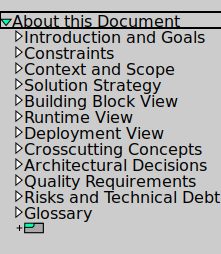This section lists hints on efficiently using the tool crystal-facet-uml and provides some general remarks on creating a software architecture and design document.
Modelling aspects that are special to the tool crystal-facet-uml are describes in this section.
Diagrams are organized as a tree. The root diagram is the title page. This can be used to state the project goal or to explain the document structure. At the second level of the tree, list the main areas to be shown, for example based on the arc42 template https://arc42.org/overview/ :

Put only few elements into each diagram. This increases understandability of the main purpuse of the diagram. Put further aspects of a topic into a separate diagram. Do not hesitate to copy an element from one diagram to the next. This is what crystal-facet-uml is good at: it keeps the model in sync.
When distributing different aspects to different diagrams, a remaining challenge may be that there is no filter on features and relationships. If for example two classes are connected via a generalization arrow and an aggregation arrow, each diagram will show both arrows even if only one is of interest for the shown aspect (except for interaction diagrams).
Solutions may be:
Add an hierarchy level, show only the outer elements in one diagram, show only the contained elements in another diagram.
Define a port at a parent to bundle multiple communication paths of children.
Separate abstract classes/components/blocks and their specializations to hide details when showing the abstract concepts and vice versa.
Extract methods to an interface to hide details when using the class.
Add a topic-specific mediator class (e.g. a risk) that is only shown in selected diagrams.
If applicable, use an interaction diagram: Interaction-Overview, Communication, Sequence or Timing. These hide features and relationships except the ones defined at the local diagram.
Put a prefix to all your elements denoting its namespace. You can then distinguish a GLOBAL_START_STATE from an AUDIO_START_STATE or global::start from audio::start.
If you are not sure if you really want to delete elements, 1) copy them to an attic-diagram and then 2) delete them from the original diagram. Note that copy, in contrast to a cut, keeps all relationships.
To change the positions of classifiers and features, drag these to the target location. Note that the relative position of classifiers towards each other affects the layout of other diagrams also.
Relationships can only be dragged in sequence and timing diagrams.
Relationships in other diagrams are auto-layouted.
crystal-facet-uml prevents to cross/overlay these two types of relationships:
.
If the layouting result is still inappropriate, move classifiers and features to other positions.
This section povides some general remarks on creating a software architecture and detailed design document.
Distinguish things that are
given constraints (problem space),
decisions, rejected alternatives and
the selected solution
Names of things are crucial: If the reader gets a wrong understanding by the name of an element, a hundred correct sentences of describing text cannot set this straight again.
Every design element needs a description, maybe a list of responsibilities: What shall this element do, what is it for? Names alone cannot explain a system part.
Be precise: Write in active form, e.g. The persistence component shall store and retrieve binary data records identified by string-based keys.
Things that are similar but not the same shall be different entities when modelling. E.g. The process in which an example application runs may be different from the storage location and may be different from the software-component. These are three things: Example_App_Process (Type: Node), Example_App_ObjectFile (Type:Artifact) and Example_App_SWComponent (Type:Component).